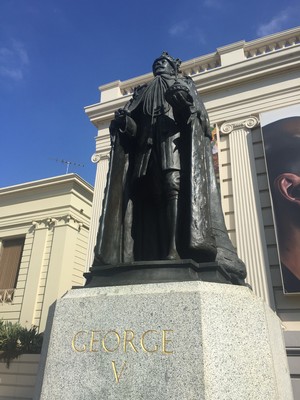A Geelong man whose art has passed through the hands of every single person reading this died peacefully in the UK this week.
In fact, almost everyone in Australia will be intimately familiar with the work of designer Stuart Devlin, who passed away aged 86.
The Abletts and Amphletts of footy and rock music fame might be Geelong’s most famous names but no other local could equal the reach of the man who designed the charming reverse side of Australia’s decimal coins.
Yes, it was Stuart Devlin who in 1964 created a menagerie of native animals in metal, everything from the cute feather tail glider on the one cent through to the paired roo and emu on the big 50.
The sleek platypus gliding beneath ripples on the 20 cent was Double Take’s favourite.
Many locals would have missed Devlin’s passing but fortunately City Hall was alert, flying its flag at half-mast and issuing a statement of respect to mark the master’s passing.
“Although he spent much of his professional life in London, he always called Geelong home,” said Mayor Bruce Harwood.
“Each of us carries a memento of his work every day in our pockets, ensuring his legacy will live on.”
Indeed. Vale, Stuart Devlin.
While on matters of design, an old bloke in Geelong has undergone something of a spruce up ahead of his 80th birthday.
King George V has hardly looked better since he took up residence as a statue in Johnstone Park way back in the late 1930s.
The actual George V died in 1936 aged 71, but his bronze counterpart has undergone a thorough cleaning and restoration in time for Georgie boy’s birthday on 6 May.
The statue was quite a work back in the ‘30s, with sculpture Wallace Anderson spending a year creating the plaster cast in 1937 before shipping it to England for casting because Melbourne lacked a foundry big enough.
From England the cast then travelled to Naples where emerged Johnstone Park George, in a dark bronze finished called ‘Herculaneum’.
From there the statue travelled back to Geelong for its unveiling in October 1938.
Now that for the time was truly a Herculaneum effort!
At the other end of the local design spectrum, a talented local team has invented clothing that tracks the wearer’s movements.
Dr Shayan Seyedin led researchers at Deakin University in engineering “strain-sensing textiles” that convert movements into electrical signals for tracking and recording physical activities.
Dr Seyedin nominated sports and physical rehabilitation as likely areas of applications.
What about prevention? Surely with the “obesity epidemic” this technology should be applied to pants.
Because, as we all know, even the smallest split can lead to a crack!







